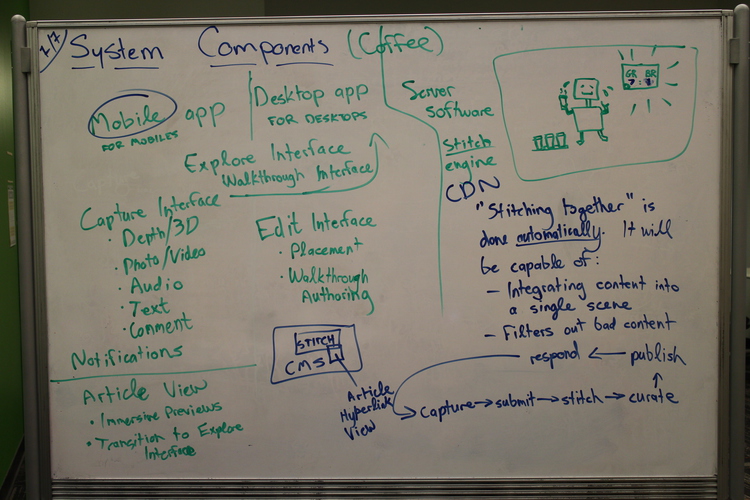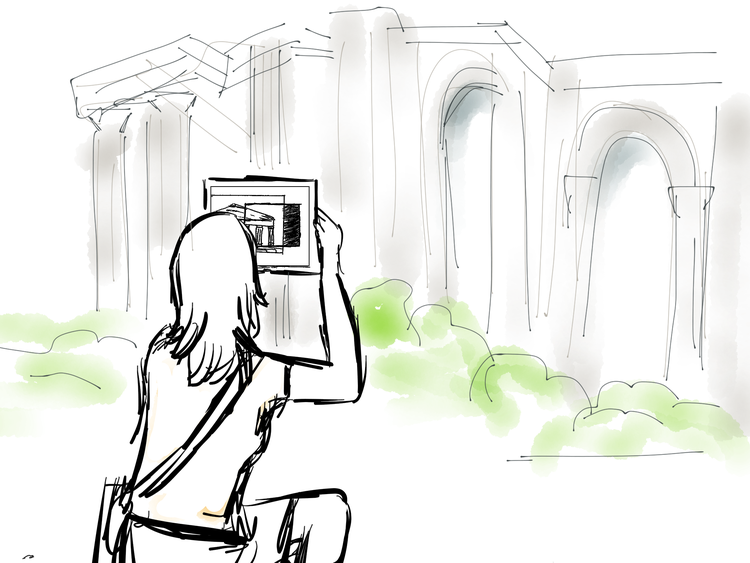After our meeting with Vince Ball at Nytec, we spent many hours developing a brand-new concept in response to our design question. We realized that a successful response, which removes the barrier between creation and consumption of journalism, should harness the power of citizen journalism at its best.
Now, what is citizen journalism, and what does it mean for it to be “at its best”? TED speaker Paul Lewis’s 2011 TEDxThessaloniki talk shared a powerful and practical vision for a future of investigative journalism in which reporters activately motivate and direct everyday people to submit the source material needed to uncover the truth. This is a different view of crowdsourcing in which citizens help reporters do their jobs rather than replace reporters altogether.
We began to wonder, what would a crowdsourced platform for immersive, expository content look like? How could it enable reporters and readers to build up a living, immersive coverage space, filled with captures, embedded content, and storytelling? How could it enable faraway walkthroughs? How could it give context to readers’ eyewitness accounts of a scene? How could it change when and why articles are written in response to events and happenings in the world?
These are all questions we are thinking about as we further develop our new concept: “Stitch”. We’ve prepared several storyboards describing “Stitch” in action, which you can view below.
What is “Stitch”?
“Stitch” is a platform that enables immersive exploration of the news through three-dimensional locations and content embedded within the space, contributed by journalists and readers alike. The platform gives publishers a powerful way to combine the best of professional and citizen journalism: readers can not only immerse themselves the very spaces where the news happens, but they can also use the depth cameras in their (future) smartphones and tablets to seamlessly contribute their own captures to the space.
What kinds of content end up in a “Stitch” environment?
In addition to 3D captures, journalists and readers may embed other media, such as video, photos, audio, or written text, at specific points in the space, thereby giving all reader contributions greater context in the target location. They may also create narrated walkthroughs of the space to highlight specific environment features or content. In this way, the “Stitch” environments also serve as a space to create new stories from contributed content.
How do “Stitch” environments fit into the news?
The 3D environments of “Stitch” would be a joint production between journalists and readers in the field, and can be populated in several ways:
- As a response to a speculative piece, in which a publication would solicit and incentivize readers to submit their 3D captures, videos, photos, and eyewitness accounts to build up an exploration space for a story.
- As a supplement to a published story, where readers would embed their own content, walkthroughs, and other content into an existing or entirely reader-contributed 3D environment.
- As a wholly reader-contributed response to an event or happening, which would provide captures and eyewitness accounts from which the publisher may generate their own published stories and other coverage in reference to the 3D environment and the content embedded in it.
Who benefits from “Stitch”?
“Stitch” benefits publishers by giving them a powerful new storytelling tool, one which gives unprecedented presence and context to the news they already cover. It also enables them to leverage the contributions of readers around the world to help journalists and readers explore, experience, and capture places they cannot be. This new way to contextualize reader contributions within a physical space also lets journalists validate their own coverage and generate new coverage in response. Finally, the immersive nature of “Stitch” and its deep integration to the publisher’s existing web coverage gives readers a new experience that extends well beyond the snippets of coverage they see elsewhere online.
“Stitch” benefits readers by offering them a compelling and immersive experience of the news by virtually taking them on-location and letting them explore for themselves. Readers who are actually on-site—especially those in places where the publisher is not—are now empowered to contribute their own captures and experiences to an environment. Further, readers can receive rewards and incentives in exchange for their valuable contributions, such as access to more content on the publisher’s website. In this way, readers are invited as collaborators to get more involved in the work news-making.
Next Steps
We’ve already begun to expand on our concept with these system component and interaction diagrams:


This week we are diving head-first into prototyping interfaces as well.

